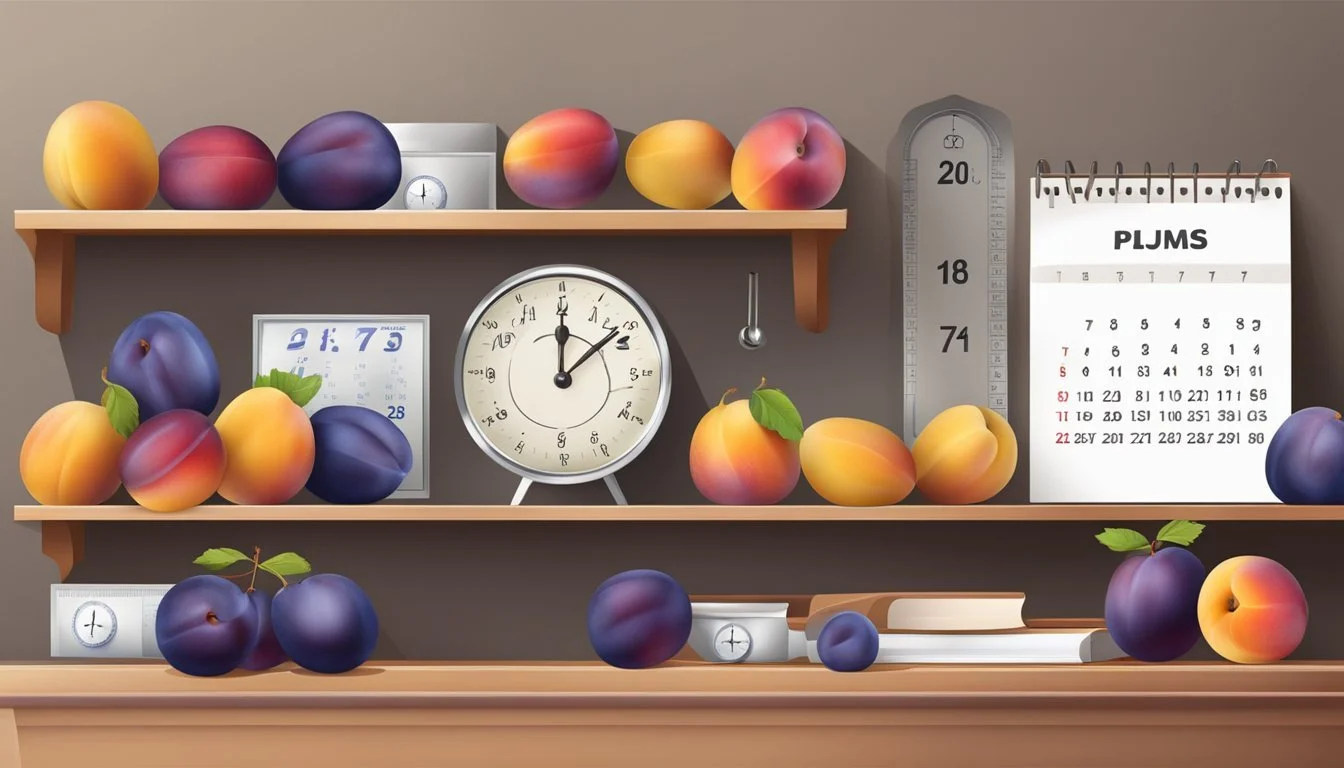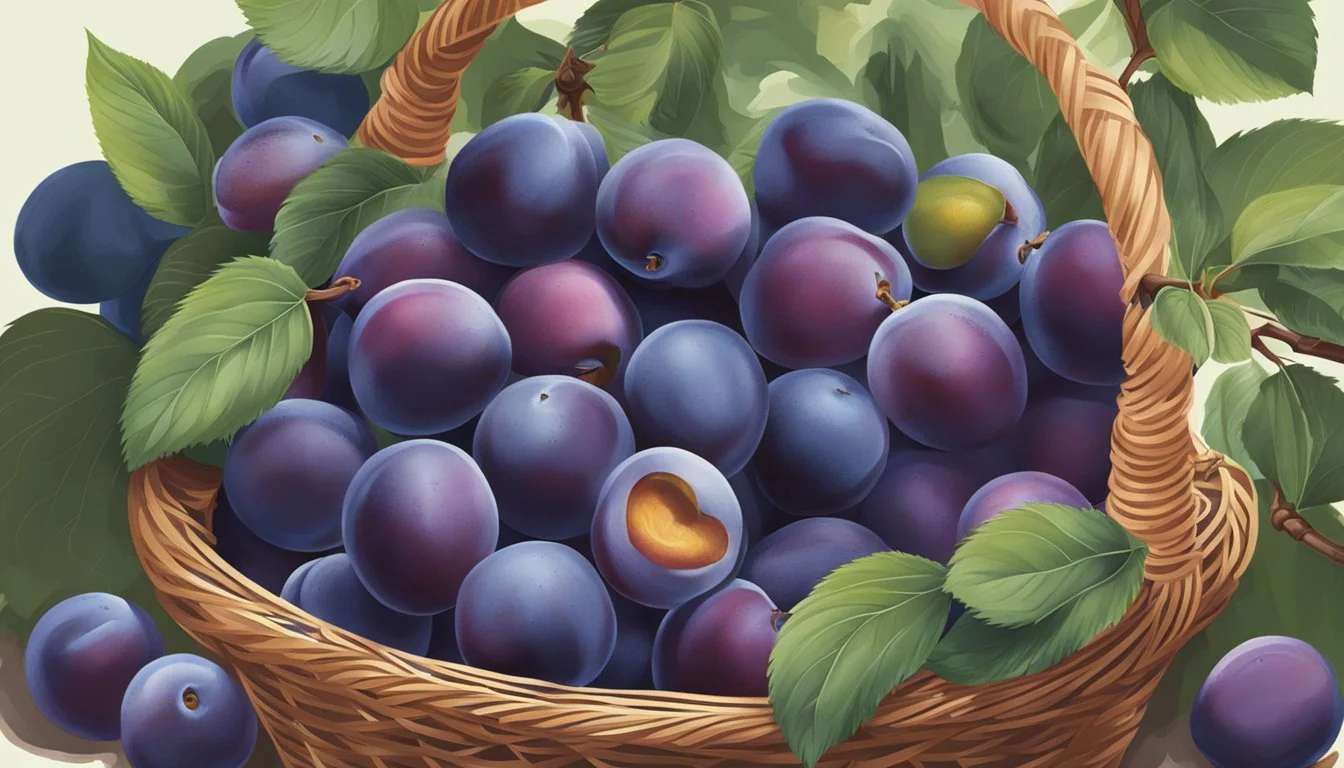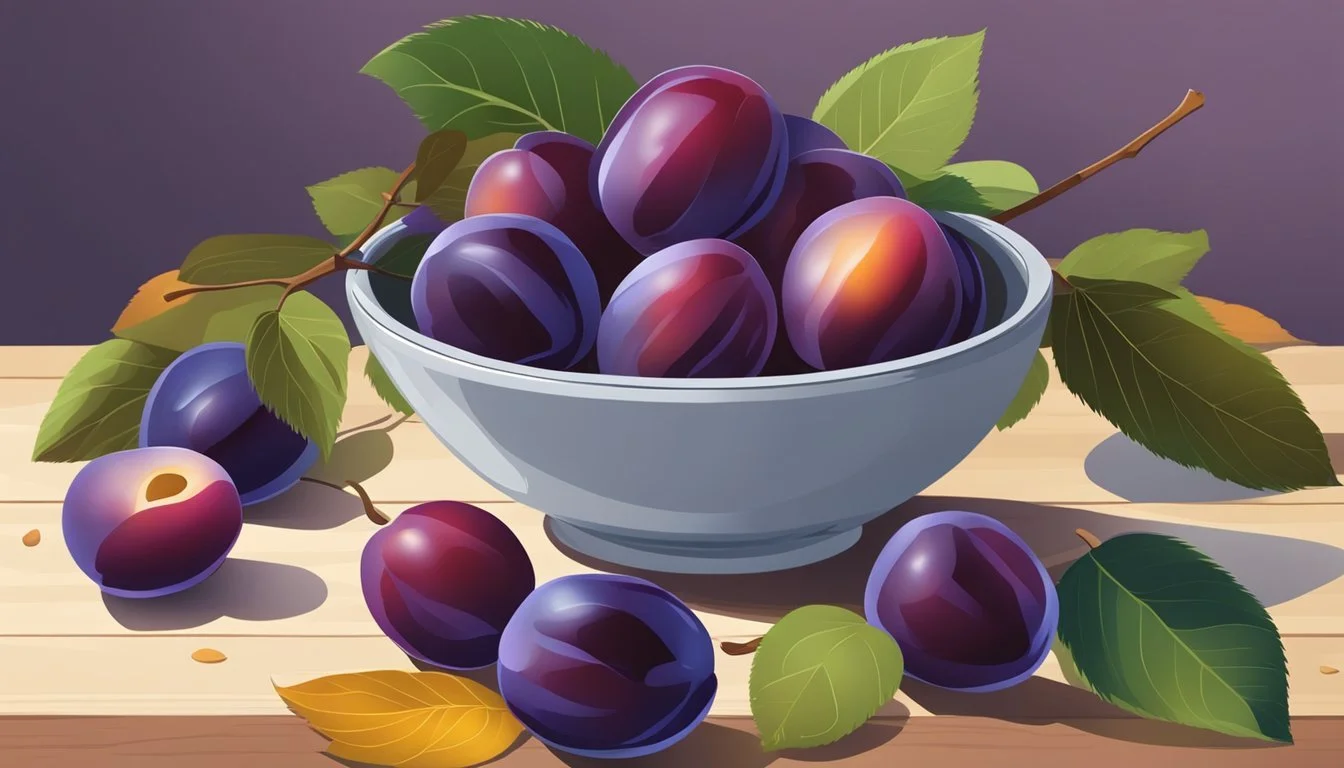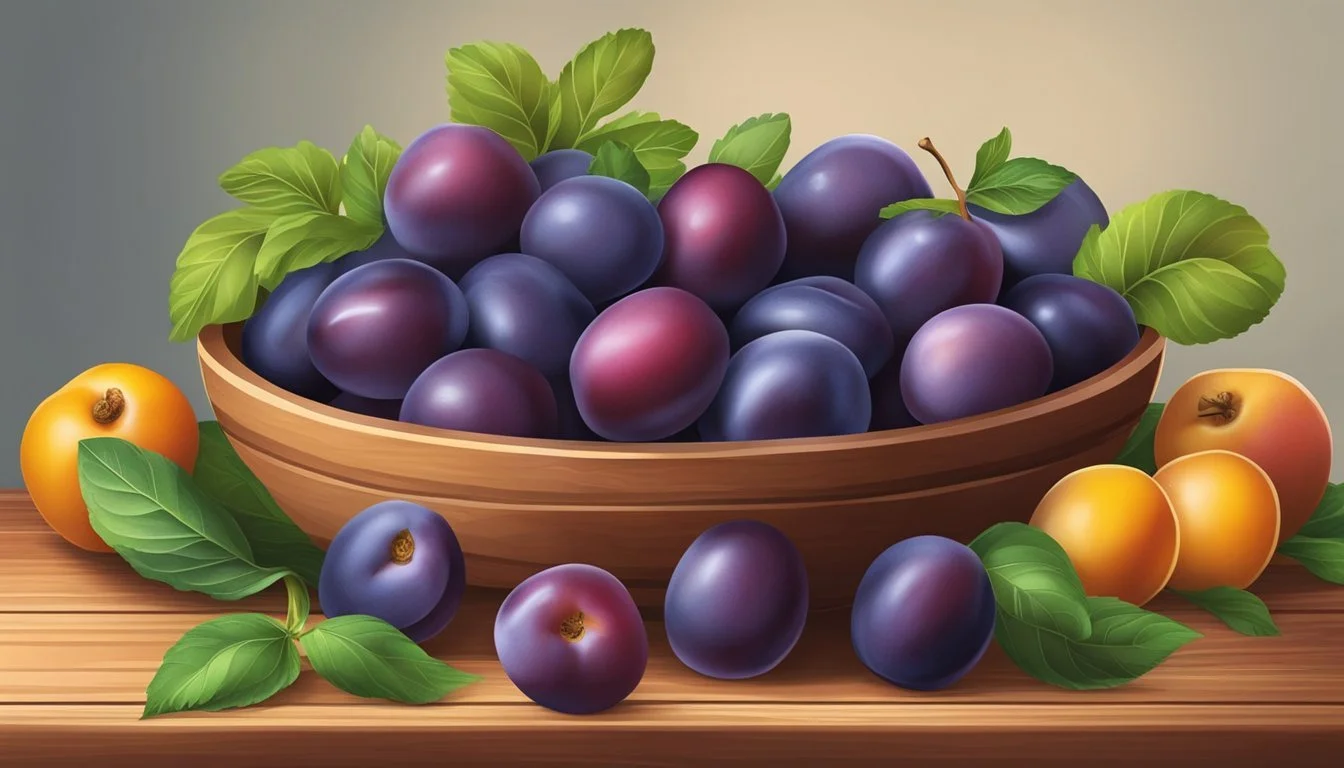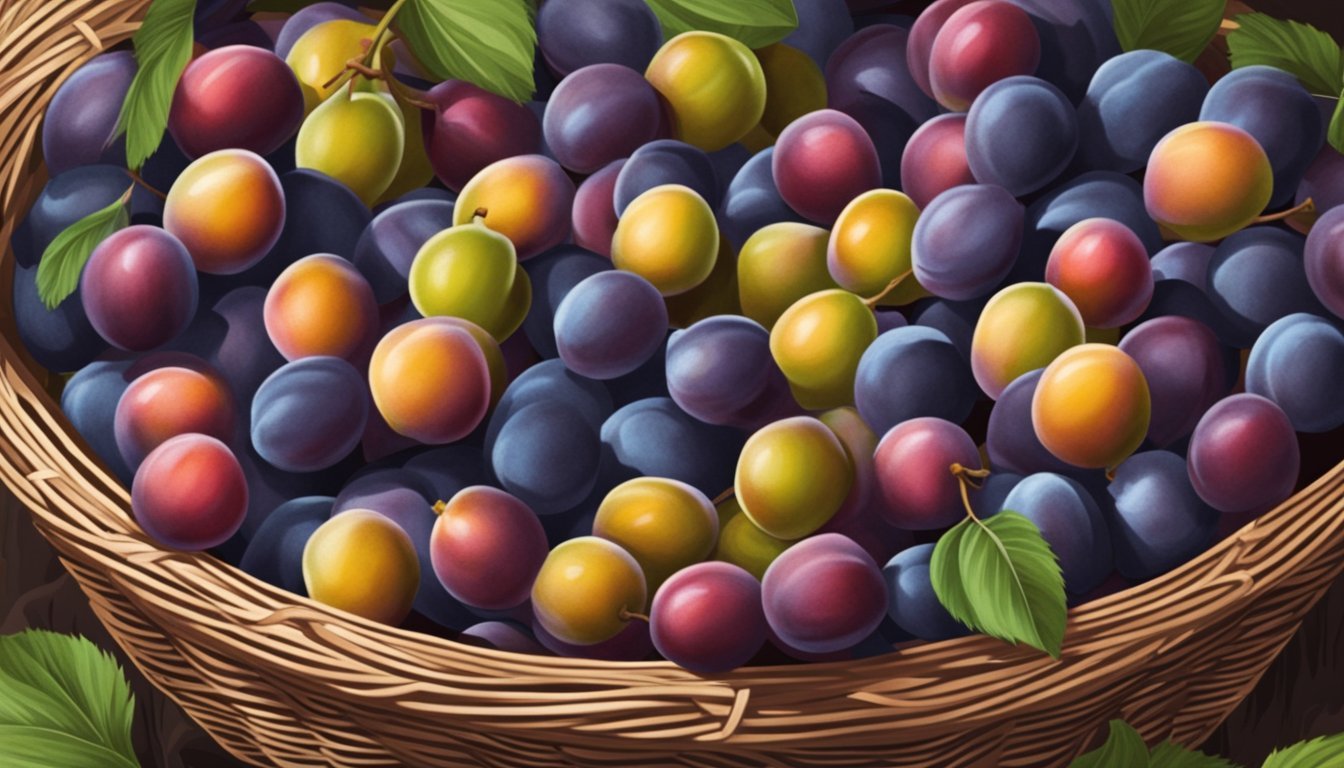How Long Do Plums Last?
Shelf Life and Storage Tips
Plums are a delectable stone fruit known for their juicy sweetness and smooth exterior. As with many fruits, their shelf life is a topic of practical interest for consumers seeking to enjoy their plums at just the right level of ripeness. The longevity of plums significantly depends on their state at purchase, whether ripe or unripe, and the chosen storage method.
Unripe plums can be left on the countertop for approximately 1 to 2 days until they reach optimal ripeness. Once ripe, plums will usually last another 2 to 3 days if kept at room temperature. However, for an extended shelf life, ripe plums can be refrigerated where they can remain fresh for 3 to 5 days, and sometimes up to a week.
The storage environment plays a crucial role in preserving the quality of plums. Storing them at a cool temperature, specifically between 32°F and 45°F, such as in the refrigerator's crisper drawer, can help slow down the ripening process. Proper storage not only extends their shelf life but also maintains the plums' desirable texture and taste. If longer preservation is required, plums can be pitted and frozen, extending their usability up to 10-12 months.
Understanding Plums
Plums are a diverse group of stone fruits that provide rich flavors, a variety of textures, and important nutrients like vitamin C and antioxidants. This section will cover the different types of plums, how to tell when they are ripe, optimal conditions for ripening, and the various characteristics of plum varieties.
Types of Plums
Plums come in a variety of shapes and colors, including blue plums and purple plums. These stone fruits belong to the rose family and are primarily categorized by their color, size, and geographical origin. Common types include European, Japanese, and Damson plums.
Ripeness Indicators
To determine if plums are ripe, one should assess their color, smell, and texture. A ripe plum typically has a deep, even color with a sweet aroma. Its skin should yield to gentle pressure, indicating softness without being overly mushy.
Optimal Ripening Conditions
For plums to ripen uniformly, they need exposure to room temperature away from direct sunlight. To hasten ripening, plums can be placed in a paper bag to concentrate the ethylene gas they emit. Plums should not be refrigerated until they reach the desired ripeness level, as cold temperatures can halt the ripening process.
Plum Varieties and Characteristics
Each plum variety has its own unique characteristics in terms of flavor, skin, and flesh texture. For instance:
European Plums: Often oval, with yellow to greenish-yellow skin; they have a sweet flavor and are excellent for drying.
Japanese Plums: Rounder and juicer, with red to purple coloring; they are more commonly eaten fresh.
The quality of plums can be judged by their firmness, lack of wrinkles, and absence of blemishes or bruising. They are celebrated not only for their taste but also for their health benefits, providing antioxidants and vitamin C.
Storage Fundamentals
Proper storage maximizes the lifespan of plums by maintaining their freshness and flavor. Depending on how long they need to be preserved, one can store plums at room temperature, refrigerate them, or freeze them for longer-term storage. Each method has specific conditions that must be met to prevent spoilage and maintain quality.
Room Temperature Storage
At room temperature, plums should be stored in a cool place, away from direct sunlight and heat sources. They are best kept in a paper bag that allows the air to circulate, which can help to ripen them evenly. Plums emit ethylene gas which can speed up ripening; hence, they should not be stored near other ethylene-sensitive produce.
Refrigerating Plums
When refrigerating plums, one should place them in a plastic bag or an airtight container in the crisper drawer to protect them from bruising and to maintain humidity levels. This method can extend the fruit's freshness for up to two weeks. It's important to avoid washing plums before refrigerating as added moisture can promote mold growth.
Freezing Plums
For long-term preservation, freezing is an effective option. One should first wash, dry, and cut the fruit into wedges, laying them out on a cookie sheet to freeze individually. Once frozen, the plum wedges can be transferred to an airtight container or a sealed plastic bag. This method can keep plums for up to 10-12 months, though flavor and texture may change slightly after thawing.
Shelf Life Determinants
The longevity of plums is determined by several key factors, including their stage of ripeness, storage conditions, and exposure to ethylene-producing fruits. Understanding these can help maintain freshness and prevent premature spoilage.
Factors Affecting Plum Longevity
Ripeness: Unripe plums continue to ripen at room temperature, usually within 1-2 days, driven by the natural production of ethylene gas. Once ripe, their shelf life is extended by cooler temperatures. Freshness is gauged by the plums' firmness and lack of soft spots.
Temperature: Plums last longer when stored in a refrigerator, typically lasting up to two weeks. At room temperature, ripe plums generally remain fresh for about 2-3 days.
Ethylene Exposure: Keeping plums away from high-ethylene producing fruits like bananas and apples can prevent them from ripening too quickly.
Damage: Physical damage to plums, like cuts or bruises, accelerates deterioration as it allows bacteria and mold to infiltrate more easily.
Storage Tips:
Storage Location Unripe Plums Ripe Plums Room Temperature 1-2 days (until ripe) 2-3 days Refrigerator Not recommended 3-5 days, possibly up to a week
Signs of Plum Spoilage
Visual Cues: Spoiled plums often exhibit dark spots or mold growth, indicating bacterial activity or fungal infection. Discoloration and wrinkles can also signal spoilage.
Softness: A plum that has become overly soft or has developed soft spots is likely past its peak ripeness and beginning to deteriorate.
Odor: Any off-smelling aroma is a strong indicator that a plum is bad and should not be consumed.
It's important for consumers to regularly inspect their plums and remove any spoiled ones to prevent the spread of bacteria to other fruits.
Plum Handling Techniques
Effective plum handling techniques are vital for maximizing the longevity and quality of the fruit. From washing plums to optimizing their ripening and preventing spoilage, each step is crucial for maintaining freshness and flavor.
Washing and Preparing
Before consuming or storing plums, they should be washed to remove any pesticides, dirt, or bacteria. Washing should be done under cold running water, and it is recommended to use a soft brush on smooth-skinned plums. Washing is also crucial prior to any preparation method to ensure there is no cross-contamination.
Do not wash plums before storing as moisture can promote spoilage.
Wash just before eating or preparing to prolong shelf life.
Ripening Processes
Plums continue to ripen after being harvested. If one receives unripe plums, the fruit can be left at room temperature to induce the ripening process. Plums produce ethylene gas, which is a natural compound that promotes ripening. To hasten ripening, store plums in a paper bag, which traps ethylene gas close to the fruit.
Room Temperature:
Store unripe plums at room temperature away from direct sunlight.
Place plums in a paper bag to ripen faster.
Preventing Fruit Spoilage
Proper storage is key in preventing plums from spoiling. Once ripe, plums should be stored in the refrigerator to extend their shelf life. Plums should not be stored under high pressure or in airtight containers as they need air circulation to prevent mold and fermentation.
Refrigeration:
Store ripe plums in the crisper drawer for 3 to 5 days.
Plums should be loosely stored to avoid pressure spots.
Atmosphere:
Avoid storing plums in an airtight container.
Maintain moderate air circulation to prevent mold.
Usage and Preservation
Understanding the proper techniques for using and preserving plums can enhance their utility in the kitchen and lengthen the timeframe for which they can be enjoyed.
Culinary Applications
Fresh plums are versatile fruits, used widely in culinary contexts. During summer, ripe plums are commonly enjoyed fresh due to their natural sweetness and firmness. They are also incorporated into a myriad of recipes — from baking plum pies and crafting plum jam to cooking savory sauces. Plums bear a family resemblance to peaches, nectarines, apricots, and cherries, making them an excellent substitute in recipes calling for these fruits.
Baking: Plums are a delightful addition to pies and cakes; their tartness balances the sweetness.
Cooking: They contribute depth to sauces and can be reduced to a jam-like consistency.
Versatile: Plums can be used fresh, cooked, or canned for various dishes.
Extending Plum Freshness
To extend the freshness of plums, proper storage is critical. Placing unripe plums on a countertop can allow them to ripen at room temperature. Once ripe, moving them to the crisper drawer of a refrigerator can keep them firm and fresh for a few days longer. Overripe plums, however, should be used immediately or considered for freezing to preserve their quality.
Refrigerated: Ripe plums should be refrigerated to slow down the ripening process, where they can last about 3-5 days.
Freezing: Freezing plums can substantially extend their shelf life. Here's how to freeze them properly:
Preparation: Wash the plums, remove pits, and cut them into quarters.
Freezing Method:
Sheet Freezing: Arrange the plum pieces on a baking sheet in a single layer to freeze them individually, then transfer to an airtight container or freezer bag.
Puree: Plums can also be pureed and frozen for later use in desserts or sauces.
Plums can remain in good quality for about 10-12 months when frozen.
Health and Nutrition
Plums are a nutritious fruit offering a variety of health benefits, largely attributed to their rich content of antioxidants and fiber. They are regarded as a good source of several vitamins, most notably vitamin C, which plays a crucial role in maintaining a healthy immune system and skin health.
Nutrient Profile of Plums:
Antioxidants: Plums contain anthocyanins, which are flavonoids that give the fruit its vibrant color and contribute to its antioxidant properties. These compounds help neutralize harmful free radicals, potentially reducing oxidative stress and lowering the risk of chronic diseases.
Fiber: This fruit is a good source of dietary fiber, which supports digestive health. Fiber aids in regulating the digestive system, can help with maintaining a healthy weight, and may lower cholesterol levels.
Vitamins: Including vitamin C, plums also contain vitamin K, vitamin A, and several B-complex vitamins, contributing to overall well-being and essential bodily functions.
A table summarizing the nutritional elements found in plums:
Nutrient Benefit Antioxidants Combat oxidative stress, may reduce disease risk Fiber Supports digestive health, aids weight maintenance Vitamin C Essential for immune function, skin health Vitamin K Important for blood clotting and bone health Vitamin A Crucial for vision and immune health B Vitamins Aid in energy metabolism
Including plums in one’s diet could beneficially impact their health, especially when consumed as part of a balanced and varied diet. Their natural sweetness and nutritional profile make them an excellent snack option or a tasty addition to a range of culinary dishes.
Additional Tips
When it comes to extending the shelf life of plums, proper selection and storage techniques are pivotal. These additional tips encompass strategies for selecting high-quality plums and common pitfalls to avoid.
Selecting High-Quality Plums
It is essential that consumers choose plums that are in their prime. Ripe plums should have a uniform color and yield slightly to gentle pressure, indicating the ideal firmness. They should be free of blemishes or soft spots, which can indicate premature spoilage. Those belonging to the rose family should ideally be fragrant, a sign of good quality.
Avoiding Common Pitfalls
Consumers sometimes handle plums too roughly or apply too much pressure when checking for ripeness. Such handling can cause bruising, leading to quick spoilage. For unripe plums, minimal handling is advised, allowing them to ripen without forming soft spots. Those who encounter plums with wrinkles or a loss of firmness should understand these are signs that the fruit is past its prime.



